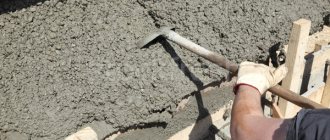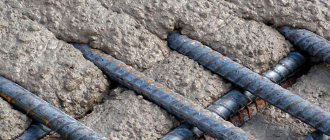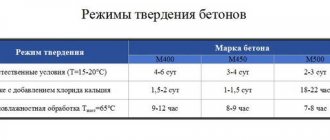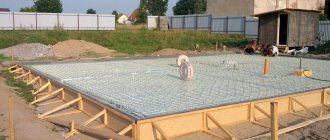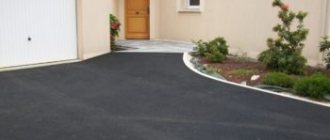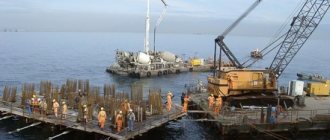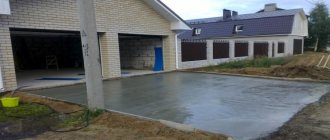Concrete is a building material that is obtained by mixing cement, water, crushed stone and sand. The presence of additional components in the mixture is allowed. It is impossible to imagine any construction site without concrete. However, it is extremely important not only to select the correct composition of the material, but also to observe all the features of the technological process of pouring concrete. Many construction organizations offer concrete pouring services at a competitive price, but it is important to control the pouring of the floor or foundation to be sure of the quality of the work.
How to prepare the surface?
It is important to properly prepare the surface first. In the process of surface preparation, depending on the assigned tasks, the following is performed:
- waterproofing works,
- installation and fastening of formwork,
- installation of beacons to control the filling level of the solution,
- installation of reinforcing materials.
The final cost of pouring a floor with concrete from a mixer or building a house foundation depends on the amount of preparatory work.
Cost of concreting - pouring and laying concrete
Construction of walls and ceilings, foundations, production of screeds, arrangement of blind areas, formation of sidewalk paths - all these construction processes are carried out with concrete work. Pouring a solution is a difficult technological procedure that requires knowledge, practical skills, and time. Involving specialists familiar with the specifics of production will help solve the problem.
What is included in the prices?
When pricing, the list of works is taken into account - it is compiled in accordance with construction standards and instructions. An approximate plan of operations that is followed during concrete pouring:
- installation of formwork - removable or permanent;
- installation of a reinforcing frame;
- mixing the solution - with a mixer or manually;
- delivery to the construction site (if production is carried out outside);
- filling (unloading) – done manually or machine-wise (with a mixer);
- compaction - if necessary, the poured mixture is compacted using vibration devices;
- dismantling removable formwork;
- caring for concrete during the process of its final hardening and strength gain - there are companies that provide a similar service for 4 weeks for an additional fee.
Factors influencing the cost of concreting
How exactly the pouring is performed and what composition the solution has depends on the type of structure, weather conditions, and the quality of the components. The more complex the technology and recipe, the more expensive the service (check out the approximate prices for concreting).
1. Technology. It is selected based on the operating conditions and purpose of the structure. If high strength requirements are placed on a building system, concreting necessarily includes the installation of reinforcement. The result is a composite that can withstand large bending and tensile loads - reinforced concrete. Sometimes work is carried out without reinforcement with metal.
2. Type of reinforcement. Depending on the required characteristics of reinforced concrete (one of them is the design load on the foundation), different reinforcement is used for the frame. Steel wire or rods are used, the cost of which also increases the cost of concreting. Labor-intensive tying of round reinforcement with wire leads to an increase in the cost of the service. Often, instead of knitting, welding is used - this is a faster method, but it requires the involvement of a qualified worker.
3. Brand. The prices are influenced by what kind of composition is laid (the higher the brand, the greater the density). In this case, an important point is vibration, used for seals of grade M300 and higher. To give the mixture the desired parameters, special equipment and a knowledgeable specialist are required. Lightweight concretes have a lower cost per cubic meter because they do not require compaction.
4. Type of formwork. In addition to traditional wooden collapsible structures, special devices are often used: suspended (for stairs) or sliding (for monolithic walls of high-rise buildings). Modern permanent forms are also popular. They are easy to install and do not require subsequent disassembly. If the walls are concreted, the permanent formwork becomes an element of strengthening the building. A cubic meter of solution, taking into account the cost of such equipment, is more expensive than pouring it into reusable molds.
5. Delivery by mixer. The industrially produced material has more stable characteristics compared to the composition of the handicraft production. The price of a factory mixture depends on the cost of ingredients, class of equipment, overhead costs, and distance to the construction site.
6. Laying method. Critical structures often require that pouring and spreading occur simultaneously. In this case, the work must be performed using an automated method. Unloading from the mixer is not cheap, but it cannot be avoided at high densities (in kg/m3) and an increased proportion of cement in the recipe. This material hardens quickly and must be installed quickly.
If the mixer's access to the construction site is difficult, pouring is carried out manually. A long wooden trough is brought from the container and connected to the formwork. The solution is pushed through the chute manually. If floors are being concreted, starting from the second floor, manual supply is carried out using a special “bell” and a truck crane (the use of lifting equipment also affects the cost).
7. Personnel qualifications. Complex work requires a high level of professional training. Not every ordinary builder knows how to perform concreting if the formwork is poured from different heights. Paying for skilled labor increases costs per cubic meter.
The cost per 1 m3 is adjusted depending on the season. If concreting is carried out in winter, additional measures are taken to heat the mixture and anti-frost additives are introduced. By agreement with the customer, serious construction companies carry out paid work to care for the concrete until it completely hardens.
What equipment will you need?
Features of the technological process require the use of the following equipment and tools:
- mesh for reinforcement or plastic reinforcement,
- gutter,
- beacons,
- container for moving the solution.
There are two options for pouring concrete: from a mixer that arrived at the construction site, or directly after preparation on site. The solution must be poured no later than 6 hours after mixing. The solution is poured to a height using a concrete pump. If you need to fill the floor or foundation of a small private house, you can prepare the solution directly at the construction site using a concrete mixer.
Prices for concreting:
The main operations of monolithic work will cost the customer the following amount (rub.):
- footing – from 2200 per cubic meter
- screed – from 400 per square
- installation and demoulding of panels – from 300 per square
- concrete laying – from 1150 per cubic meter
- knitting frames/mesh – from 1500 per ton of reinforcement
- foundation – from 4100 per cubic meter
- columns – from 4600 per cubic meter
- walls – from 4100 per cube
- stairs – from 7200 per cubic meter
- floors – from 6300 per cubic meter
- built-up waterproofing – from 300 per square
- coating waterproofing – from 130 per square
- insulation – from 280 per square
- porch – from 300 per square
- blind area – from 450 per square
- terrace – from 900 per cubic meter
- grillage – from 2700 per cubic meter
It is very difficult to accurately order volumes of ready-mixed concrete using a mixer. When manually mixing the missing amount, you should focus on 1000 rubles/m 3.
Call today to receive a more detailed estimate from our staff.
Monolithic construction
Monolithic work is fundamental to the construction of any modern house; modern technologies allow this to be done as quickly and efficiently as possible. Our company carries out monolithic work in Moscow, the Moscow region, as well as in the nearest regions (up to 300 km from Moscow).
Source: mono-lit24.ru
How is the solution poured?
Different technologies and filling methods are used for different objects. It is important to control the level of concrete pouring and eliminate the possibility of slopes. If the solution is mixed directly on the site, follow the proportions of the components. The strength of the future coating directly depends on the quality of the fill. Filling the floor should be done in one approach.
Buy sand in Balashikha
Sand is one of the first materials needed at a construction site. Without sand you can’t pour a foundation, you can’t lay a brick, you can’t make a road. In general, construction will not begin or end without sand. Rudadar is in the process of delivering sand to Balashikha. We have been working since 2016 and have delivered a “sea” of sand to private owners, organizations, and government agencies. We work with VAT.
There are 4 types of sand in Balashikha; in the table below you will see prices with delivery in Balashikha by the most popular vehicles, such as ZIL, Kamaz and Shakhman. Look at the prices, and then we’ll figure out what sand is needed for what.
Algorithm for buying sand: Choose sand -> Choose a car -> Call, write to us -> We tell you the exact price -> We discuss the time, delivery date, address, clarify the nuances -> An hour before delivery, the driver calls you and says “I’m loading, I’ll be there soon ” -> The driver arrives, unloads the money -> You give it, transfer the money - > The driver leaves
Sand. Price with delivery in Balashikha:
| Mechanized soil development (with loading) | from 300 rub./m 3 | |
| Excavation of soil manually (without securing the pit) | from 480 rub./m 3 | |
| Excavation of soil manually (with fastening of a pit, up to 3 meters deep) | from 580 rub./m 3 | |
| Installation of crushed stone and sand bases manually (with compaction and watering) | from 650 rub./m 3 | |
| Construction of a monolithic concrete foundation for columns with a volume of up to 3 cubic meters. (with installation of formwork) | from 2,500 rub./m 3 | |
| Construction of concrete pillar foundations (with installation of formwork) | from 2,400 rub./m 3 | |
| Construction of flat reinforced concrete foundation slabs (with installation of formwork and reinforcement) | from 2,300 rub./m 3 | |
| Construction of strip foundations (with installation of formwork) | from 2,200 rub./m 3 | |
| Construction of retaining walls and concrete basement walls (with installation of formwork) | from 2,250 rub./m 3 | |
| Construction of reinforced concrete columns up to 4 meters high, with a perimeter of up to 3 meters (with installation of formwork and reinforcement) | from 2,500 rub./m 3 | |
| Construction of reinforced concrete partitions up to 3 meters high, up to 200 mm thick. (with installation of formwork and reinforcement) | from 2,300 rub./m 3 | |
| Installation of reinforced concrete floors up to 200 mm thick. (with formwork and reinforcement) | from 2,300 rub./m 3 | |
| Concrete preparation device (without mesh reinforcement) | from 1,500 rub./m 3 | |
| Concrete preparation device (with reinforcement with road mesh in one layer) | from 1,700 rub./m 3 | |
| Monolithic works in a complex for the installation of a foundation slab | from 3,350 rub./m 3 | |
| Installation of monolithic floors in a complex (industrial) | from 3,150 rub./m 3 | |
| Construction of strip monolithic foundations (complex) | from 4,350 rub./m 3 | |
| Installation of monolithic grillages (complex) | from 4,750 rub./m 3 | |
| Installation of bored piles (complex) | from 6,550 rub./m 3 | |
| Construction of monolithic columns, beams, lintels (complex) | from 6,750 rub./m 3 | |
| Construction of monolithic walls (complex) | from 5,650 rub./m 3 | |
| Construction of monolithic stairs and flights (complex) | from 8,450 rub./m 3 | |
| * All materials are certified! | ||
| ** Company guarantee for all types of work and building materials! | ||
| Material | Price per cube* | ZIL 5 cubes | KAMAZ 8 cubic meters | Kamaz 10 cubic meters | Shahman 20 cubes |
| River sand | 550 | 5500 | 7500 | 8500 | 15500 |
| Quarry sand | 450 | 5000 | 6800 | 7500 | 13500 |
| Alluvial sand | 600 | 5500 | 8000 | 9000 | 16500 |
| Sand sifted | 600 | 5500 | 8000 | 9000 | 16500 |
| Sandy soil | 200 | 3800 | 5000 | 5500 | 8500 |
*Price for downloads, excluding delivery
Cash, To card, Sberbank Online, Cash account
These are indicative prices, because... There are many districts in Balashikha, some closer to the base, some further. The price from these prices will be +- 500 rubles. If you want to know the exact prices, call or write to us, we will be happy to calculate delivery to you and help you choose the right option. We know everything about sand, to put it mildly, so we will advise you. +7 926 930 7869, +7 495 532 2231, [email protected]
Which sand to choose:
The choice of sand in Balashikha is large, to suit any need.
Quarry sand
Seeded quarry sand
Washed quarry sand
The washed one is used on concrete, on mortar, everywhere. After all, this is pure sand; when natural quarry sand is washed, all impurities are removed: silt, clay, loam, soil. And in the sand only sand remains. Moreover, 1.5-2.5 mm sand is good, it will make high-strength concrete, because the larger the size of the sand grains, the better. Size module (1.8-2.5mm)
Filtration 3-5m/day.
Sandy soil
This is natural quarry sand mixed with soil. After all, quarry sand is extracted not from the river, but from underground: the turf is cut off, and sand soil is located under it. It is often bought to raise the level of the site
, this is the cheapest way.
river sand
Construction of formwork
The most popular method is pouring concrete into formwork. The construction of a special barrier helps give the structure its shape and prevents the solution from spreading.
Removable formwork can be disassembled and used several times. There is also stationary equipment that is made of polystyrene and cannot be recycled. The formwork must be strong, not fall apart or deform under the influence of solution pressure; if necessary, it must be covered with a frame. Properly assembled formwork guarantees the strength of the concrete structure and the reliability of the entire structure. The formwork can be filled with mortar either manually or automatically.
Recommendations for filling
When considering how to properly pour concrete, you need to take into account that laying requires careful compliance with building codes. To avoid mistakes during the work process, it is advisable to consider the following recommendations:
- Saving on the grade of concrete can lead to a decrease in the strength and load-bearing capacity of the building, so when pouring it is necessary to use exactly the type of material that meets the objectives.
- The bay cannot be interrupted for more than 2 hours. And even in this case, it will be necessary to loosen the surface to mix the already poured and poured solution.
- When laying in a trench more than 2 meters deep, the mixture should be fed through a chute to avoid soil collapse on the walls.
- If the solution is supplied under strong pressure, this can lead to the undermining of unsecured reinforcement.
- The formwork is removed only after the concrete has gained strength above 50% of its original strength. As a rule, at temperatures above +7℃ it takes about a week to set.
Compliance with the sequence and laying rules provides concrete structures with the necessary strength characteristics. The use of modern equipment and properly selected solution has a great influence on the quality of work. Thanks to this, poured concrete acquires the required reliability, safety and durability.
Author of the article
GESN for preparing a solution using a mechanized method
In the same collection GESNr69, it is possible to select a price in the estimate for preparing a solution using mortar mixers. The table containing the standards for this type of work is GESNr69-11. By type of solution, the norms in this table coincide with the norms from GESNr69-12.
However, in terms of the scope of work, GESN for preparing a solution manually differs significantly from the standards for creating mixtures using a mechanized method. The standards of the table GESNr69-11 include the dosage of components for the solution, their hand-carrying, loading into the mortar mixer and further preparation in it. The volume of work is measured in cubic meters, or m3.
Sand delivery in Balashikha
We've sorted out the types of sand, now let's talk about delivery. To satisfy the client as much as possible, we have different machines in our fleet, from small to large. Little nimble Zils that will go everywhere. Large 20 cc trucks, which can bring a large volume of sand on one flight and save on delivery.
All machines are mainly rear unloading, so if you need side unloading, please inform us when you submit your request. If you do not warn, a rear unloading machine will arrive.
Our machines and dimensions:
ZIL, GAZ
Body volume. 5 cubes long. 5.63m Width. 2.07m Height. 2.14m Unloading: rear
Body volume. 8 cubes long. 5.63m Width. 2.07m Height. 2.14m Unloading: rear
Kamaz 10 cc
Body volume. 10 cubes long. 7.6m Width. 2.5m Height. 2.83m Unloading: rear
Shahman f3000 or equivalent
Body volume. 20 cubes long. 8.3m Width. 2.49m Height. 3.45m

